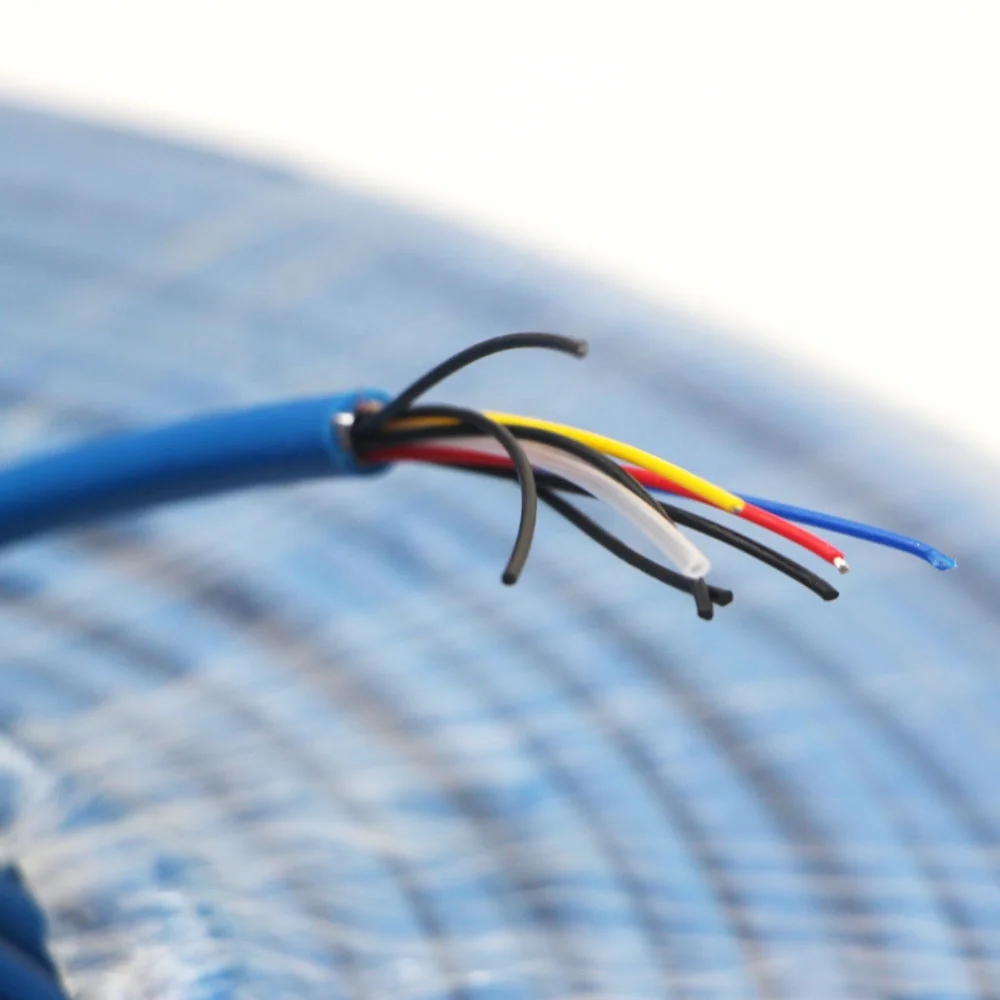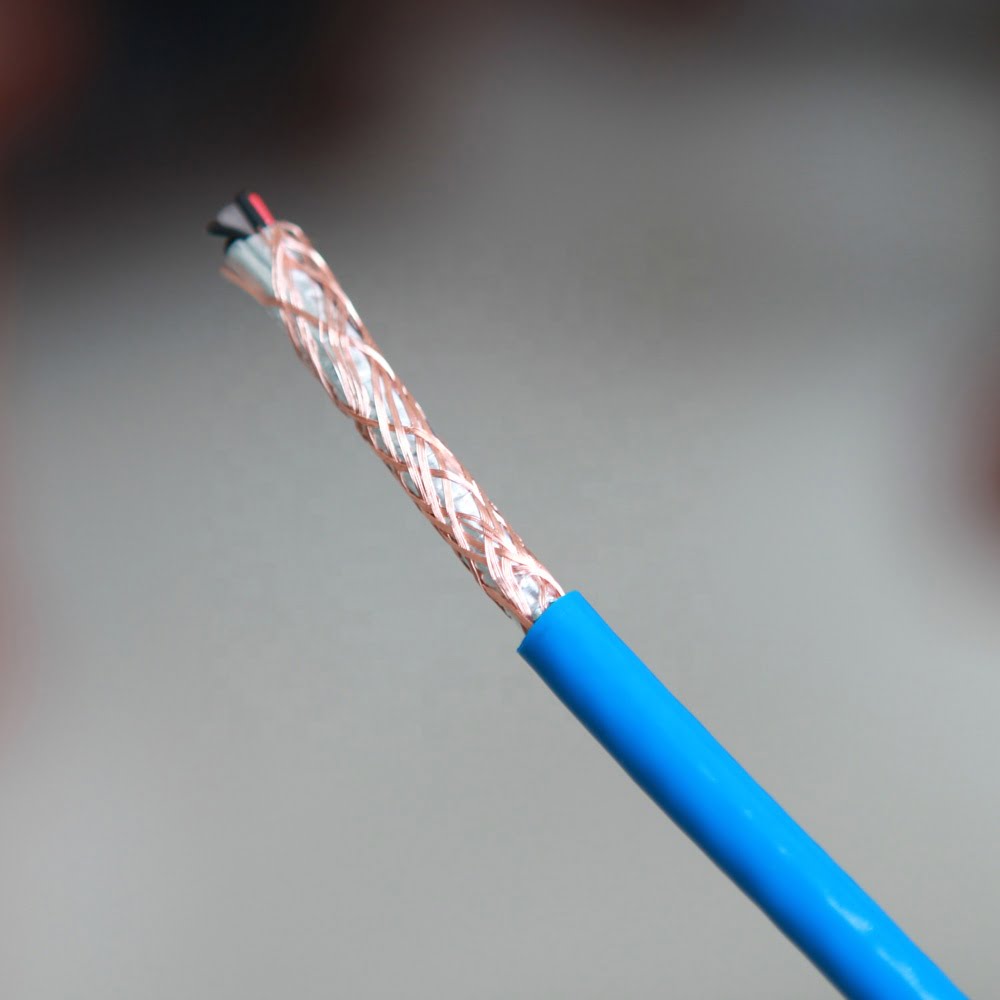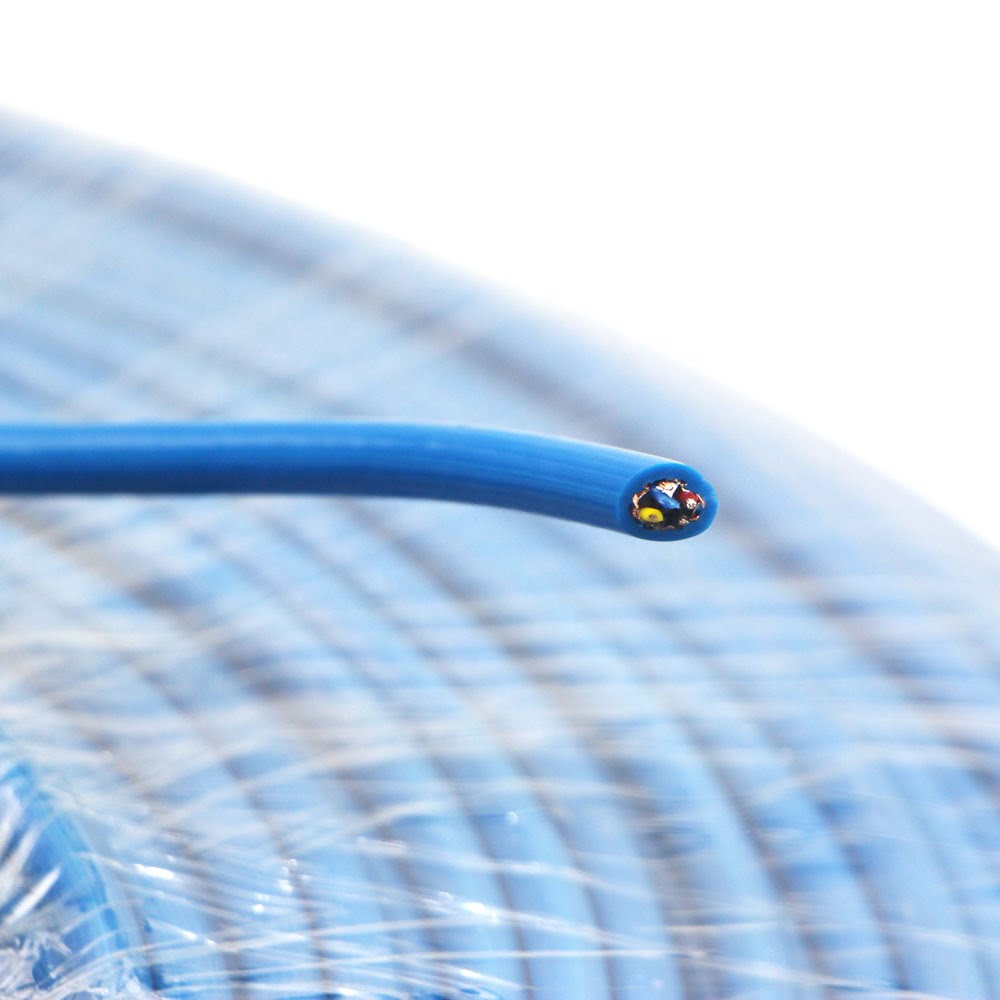مقدمه 4 کابل های اصلی با لوله های دریچه ای

در سالهای اخیر, 4 کابل های اصلی با لوله های دریچه به عنوان اجزای اساسی در زمینه مهندسی ظاهر شده اند, به ویژه در کاربردهای مربوط به اندازه گیری فشار آب و تشخیص سطح سیال. این کابل های تخصصی برای ارائه اندازه گیری قابل اعتماد و دقیق پارامترهای مختلف سیال طراحی شده اند, که برای صنایع متعدد بسیار مهم است, از جمله ساخت و ساز, نظارت بر محیط زیست, و مدیریت منابع آب. اهمیت این کابل ها نه تنها در طراحی ساختاری آنها بلکه در عملکرد آنها نهفته است, که فناوری پیشرفته را برای عملکرد پیشرفته ادغام می کند.
ساختار اصلی a 4 کابل هسته به طور معمول شامل چهار هادی است که انتقال داده های مربوط به سیگنال های الکتریکی تولید شده توسط سنسورهای فشار را امکان پذیر می کند. گنجاندن لوله های دریچه ارتباط با مبدل های فشار را به روشی که نوسانات فشار اتمسفر را جبران می کند ، تسهیل می کند. این طرح به ویژه در محیط هایی که سطح آب و فشارها به دلیل شرایط محیطی می توانند به سرعت تغییر کنند ، از اهمیت ویژه ای برخوردار است. از آنجا که نمونه های آب اغلب در معرض تغییرات فشار جوی قرار می گیرند, استفاده از کابل هایی با لوله های دریچه تضمین می کند که اندازه گیری ها دقیق و قابل اعتماد باقی بمانند, بنابراین جلوگیری از عدم دقت داده های احتمالی.
این کابل ها به طور گسترده در سناریوهای مختلف از نظارت بر سطح آب در مخازن استفاده می شوند, برای مدیریت فشار در سیستم های آب صنعتی. با حفظ فشار مرجع پایدار از طریق لوله های دریچه, مهندسان می توانند اندازه گیری های واقع گرایانه ای کسب کنند که فرایندهای تصمیم گیری را آگاه می کنند. بعلاوه, تطبیق پذیری 4 کابل های اصلی به آنها اجازه می دهد تا در انواع نصب ها به کار گرفته شوند, از برنامه های سطح سطح گرفته تا سیستم های چاه عمیق, افزایش کاربرد آنها در زمینه های مختلف مهندسی.
در نهایت, درک اهمیت 4 کابل های اصلی با لوله های دریچه برای متخصصانی که درگیر مهندسی و علوم محیطی هستند ضروری است, از آنجا که این کابل ها نه تنها دقت اندازه گیری را بهبود می بخشند بلکه مدیریت و نظارت مؤثر بر منابع آب را نیز تسهیل می کنند.
درک اندازه گیری فشار آب

اندازه گیری فشار آب جنبه مهمی در صنایع مختلف مانند هیدرولوژی است, لوله کشی, و نظارت بر محیط زیست. این مفهوم حول درک نیرویی است که توسط آب اعمال می شود, که می تواند به طور قابل توجهی بر کارآیی و ایمنی سیستم تأثیر بگذارد. اندازه گیری فشار در درجه اول مربوط به تعیین فشار در سیستم آب است, به طور معمول در پوند در هر اینچ مربع اندازه گیری می شود (PSI) یا پاسکال (پا). علاوه بر, قرائت دقیق برای نظارت بر یکپارچگی سیستم های تحویل آب و اطمینان از اینکه سطح فشار در تحمل های عملیاتی ایمن باقی می ماند بسیار مهم است.
برای اندازه گیری فشار آب از انواع مختلفی از سنسورها استفاده می شود, با هر یک از مزایای مشخص بسته به کاربرد. انواع سنسور متداول شامل piezoresistive است, ازازین, و سنسورهای سنجش کرنش. سنسورهای Piezoresistive به ویژه به دلیل صحت و پاسخگویی آنها ارزش دارند, مناسب کردن آنها برای برنامه های کاربردی که نیاز به اندازه گیری فشار دقیق دارند. سنسورهای خازنی رویکرد متفاوتی ارائه می دهند, زیرا آنها فشار را بر اساس تغییرات در ظرفیت اندازه گیری می کنند, در حالی که سنسورهای سنج کرنش با اندازه گیری اعوجاج در یک ماده تحت فشار عمل می کنند. هر نوع سنسور از نظر حساسیت و قابلیت اطمینان مزایای منحصر به فردی را ارائه می دهد, اجازه راه حل های متناسب بر اساس الزامات عملیاتی خاص.
برای تسهیل انتقال مؤثر داده ها از این سنسورها به سیستم های نظارت, 4 کابل های اصلی اغلب به کار می روند. این کابل های تخصصی از چهار هادی تشکیل شده است, که با اجازه انتقال همزمان سیگنال های متعدد ، قابلیت های ارتباطی را افزایش می دهد. طراحی 4 کابل های اصلی, اغلب با لوله های دریچه ای درج شده است, تضمین می کند که هرگونه فشار فشار تشخیص داده شده توسط سنسور به طور دقیق و کارآمد به سیستم های نظارت ارتباط برقرار می شود. این انتقال یکپارچه داده ها برای ایجاد یک مرور کلی از شرایط فشار آب ضروری است. خوانش دقیق فشار آب نقش مهمی در جلوگیری از خرابی سیستم دارد, عملیات بهینه سازی, و اطمینان از رعایت استانداردهای نظارتی در بخش های مختلف.
اهمیت لوله های دریچه در طراحی کابل

لوله های دریچه ای نقش مهمی در عملکرد کلی دارند 4 کابل های اصلی, به ویژه آنهایی که برای اندازه گیری فشار آب طراحی شده اند. این لوله ها به عنوان مؤلفه های اساسی عمل می کنند که باعث تساوی دقیق فشار اتمسفر در سیستم می شود. در تنظیماتی که اندازه گیری سطح سیال بسیار حیاتی است, مانند سیستم های مدیریت آب, وجود لوله های دریچه برای اطمینان از اینکه سنسورها و مبدل ها می توانند قرائت های دقیقی ارائه دهند بسیار مهم است.
عملکرد اصلی لوله های دریچه این است که هوا وارد کابل شود, که به تعادل فشار داخلی و خارجی که بر روی دستگاه سنجش اعمال می شود کمک می کند. وقتی مایع در دستگاه اندازه گیری بالا می رود یا می افتد, تغییرات در فشار رخ می دهد. بدون لوله های دریچه, این تغییرات می تواند منجر به خوانش نادرست شود, از آنجا که دیفرانسیل فشار ممکن است باعث شود سنسورها به طور نادرست پاسخ دهند. با برابر کردن فشار, لوله های دریچه به کاهش این اختلافات کمک می کنند, منجر به اندازه گیری سطح سیال قابل اعتماد و مداوم.
بعلاوه, لوله های دریچه در جلوگیری از ایجاد فشار منفی مؤثر هستند, که می تواند بر عملکرد سیستم اندازه گیری فشار تأثیر منفی بگذارد. در نوسان شرایط محیطی, مانند بارندگی شدید یا تبخیر سریع, اطمینان از پایداری سطح فشار بسیار مهم است. لوله های دریچه ای با اجازه فرار از هوای به دام افتاده و رطوبت ، این ثبات را تسهیل می کنند, در نتیجه خطر خطاهای اندازه گیری مربوط به فشار را کاهش می دهد که در غیر این صورت ممکن است داده های جمع آوری شده را به خطر بیاندازد.
خلاصه, ترکیب لوله های دریچه در طراحی 4 کابل های اصلی دقت و قابلیت اطمینان سیستم های اندازه گیری فشار آب را افزایش می دهد. با تساوی موثر فشار و جلوگیری از تداخل جوی, این لوله ها اطمینان حاصل می کنند که ابزارهای اندازه گیری به طور کارآمد کار می کنند, حتی در شرایط محیطی متنوع و در حال تغییر.
خصوصیات مکانیکی و مقاومت محیطی
4 کابل های اصلی با لوله های دریچه ای برای نشان دادن خصوصیات مکانیکی استثنایی طراحی شده اند, آنها را برای کاربردهای مختلف ایده آل می کند, به ویژه در محیط های چالش برانگیز مانند فاضلاب و تمیز کردن سیستم های آب. یکی از ویژگی های برجسته این کابل ها مقاومت مکانیکی بالای آنهاست, که به آنها اجازه می دهد بدون به خطر انداختن یکپارچگی ، در برابر استرس جسمی قابل توجهی مقاومت کنند. این دوام در سناریوهایی که کابل ها ممکن است ساییدگی یا تأثیرات عناصر خارجی را تجربه کنند بسیار مهم است, اطمینان از عملکرد مداوم در طول زمان.
یکی دیگر از ویژگی های کلیدی 4 کابل های اصلی انعطاف پذیری آنهاست. این ویژگی نصب و مسیریابی آسانتر از طریق فضاهای تنگ را تسهیل می کند, که اغلب در سیستم های فاضلاب یا زیرساخت های تمیز کننده نیاز است. انعطاف پذیری این کابل ها آنها را قادر می سازد تا در اطراف موانع خم و کانتور کنند, اطمینان از اینکه آنها می توانند به روشی مستقر شوند که نقاط استرس و نقاط شکست بالقوه را به حداقل برساند. این سازگاری در برنامه هایی که کابل کشی سنتی به دلیل چیدمان غیرخطی سیستم های فاضلاب و آب ممکن است قابل دوام نباشد ، مفید است.
علاوه بر این, 4 کابل های اصلی مقاومت محیطی قابل توجهی را نشان می دهند, which is fundamental in settings exposed to harsh chemicals and varying temperatures. The materials used in manufacturing these cables are designed to resist corrosion and degradation caused by exposure to toxic substances often found in wastewater or cleaning solutions. As a result, they maintain their functionality and longevity, providing reliable operation even in the most adverse conditions. The combination of mechanical strength and environmental resilience renders these cables an optimal choice for professionals focused on ensuring efficient water pressure measurement in challenging settings.
Electrical Specifications and Safety Standards
When discussing 4 core cables with vent tubes used for water pressure measurement, understanding their electrical specifications is paramount. These cables are designed to operate effectively under specific conditions, including an operating voltage typically ranging from 300V to 600V. This voltage rating ensures that the cables can handle the electrical demands common in water pressure measurement systems without compromising safety or functionality.
Another crucial specification is insulation resistance, which usually exceeds 1000 megohms at 500V DC. High insulation resistance plays a significant role in preventing electrical leakage, promoting overall system efficiency, and ensuring user safety. In addition to these core specifications, the cables often exhibit characteristics such as low capacitance, which further enhances signal integrity and reduces interference in measurement outputs.
Adhering to established safety standards is vital in the application of these cables. Cables designed for pressure measurement in water systems must comply with relevant national and international safety guidelines, such as IEC 60529, which addresses the degree of protection provided by enclosures (IP ratings). Ensuring proper insulation, moisture resistance, and cable integrity prevents potential hazards, including short circuits and electrical fires.
علاوه بر این, these specifications contribute to the longevity and reliability of the cables in demanding environments. به عنوان مثال, exposure to water and other harsh conditions can degrade inferior products quickly. از این رو, choosing cables with robust insulation and protective features is essential for maintaining operational effectiveness in water pressure measurement applications. Overall, a comprehensive understanding of the electrical specifications and adherence to safety standards guarantees the safe and efficient functioning of 4 core cables with vent tubes.
Core Configuration and Color Coding
The core configuration of 4 core cables with vent tubes used for water pressure measurement plays a critical role in ensuring accurate data transmission and efficient operation of the associated sensors. These cables typically feature conductors with a cross-section that is optimized for both flexibility and conductivity. The choice of the conductor’s size impacts the cable’s electrical resistance, allowing for minimal signal loss and increased responsiveness. For effective performance, the cross-sectional area must be sufficient to carry the expected load without overheating. Thus, manufacturers often recommend specific conductor sizes based on the anticipated range of water pressure measurements.
In addition to the conductor cross-section, the color coding of the cables significantly enhances the usability and safety of these components during installation and maintenance. The standard color scheme employs four distinct colors: قرمز, سبز, سفید, and black. Each color is designated a specific function to streamline the identification process. به عنوان مثال, the red conductor typically correlates with positive voltage supply, ensuring that users can easily connect the cable to the appropriate terminal without confusion. Green often represents the ground connection, which is crucial for safety and the prevention of electrical shocks.
Meanwhile, the white conductor is generally utilized for sensor signal transmission, facilitating data transfer to the monitoring system. The black conductor typically serves as the negative or return path for the circuit. This systematic color coding not only minimizes installation errors but also aids technicians during troubleshooting and maintenance activities. As a result, the clear identification of functions through color coding contributes to the reliability and efficiency of water pressure measurement systems. Overall, understanding both the core configuration and the associated color coding is essential for anyone involved in the installation or maintenance of these specialized cables.
Operating Conditions and Temperature Ranges
The operational effectiveness of 4 core cables with vent tubes largely hinges on the environmental conditions and temperature ranges within which they are deployed. These cables are engineered to withstand a diverse array of operating scenarios, making them suitable for various applications, particularly in water pressure measurement systems. Specifically, these cables exhibit remarkable durability under extreme temperatures that range from -30℃ to 75℃. This versatility ensures reliable performance in diverse environments, whether in frigid outdoor conditions or in relatively hot industrial settings.
Maintaining operational integrity under such temperature variations is vital for long-term applications, particularly in fields such as environmental monitoring, industrial settings, and civil engineering. At temperatures as low as -30℃, the physical and electrical properties of the cables remain intact, thereby preventing failures and ensuring consistent readings. Similarly, at elevated temperatures up to 75℃, the integrity of the 4 core cables is preserved, allowing them to function efficiently in high-stress environments aimed at precise water pressure measurements.
علاوه بر این, these cables’ resistance to environmental factors such as humidity, abrasion, and chemical exposure contributes to their overall reliability and lifespan. The incorporation of vent tubes further enhances this design by preventing moisture ingress, which is crucial for maintaining the function of the underlying sensors. As a result, applications involving these cables can be deployed in varied locations, including underground installations and exposed outdoor environments, without compromising performance. Understanding these operating conditions and temperature ranges is essential for professionals tasked with selecting appropriate components for water pressure measurement systems, ensuring that the infrastructure remains robust over time.
Durability and Mechanical Performance Metrics
When evaluating the performance of 4 core cables with vent tubes, it’s essential to consider their durability and mechanical performance metrics. Two critical parameters to assess are the breaking load and the bending radius, both of which provide insights into the physical limits of these cables and their suitability for various applications.
The breaking load refers to the maximum load that a cable can withstand before experiencing failure or breakage. This metric is vital for understanding how much stress the cable can endure during its service life. For applications involving water pressure measurement, such as in deep-water installations, the breaking load becomes crucial in determining the cable’s ability to survive extreme conditions without compromising integrity. Depending on the application, engineers should select cables that not only meet the required breaking load specifications but also offer a safety margin, ensuring long-term reliability.
Another significant factor is the bending radius, which indicates the smallest radius that the cable can be bent without incurring damage. A small bending radius may lead to kinks or compromises in the cable’s functionality. It is particularly important when routing cables through tight spaces or around sharp corners. Understanding the minimum bending radius allows for better planning in cable installation, helping to avoid inadvertent damage that could lead to costly repairs or downtime.
In practical applications, both breaking load and bending radius should be taken into consideration together. به عنوان مثال, when installing 4 core cables with vent tubes in environments where they may be subject to tension or physical constraints, both metrics will guide professionals to make informed decisions regarding cable selection and installation methods. Ensuring optimal performance under operational scenarios is foundational for effective water pressure measurements.
Conclusion and Future Perspectives
خلاصه, the exploration of 4 core cables with vent tubes for water pressure measurement has revealed their critical role in ensuring accuracy and reliability. These specialized cables are designed to withstand the harsh environments typically encountered in water pressure applications, significantly elevating performance standards. Throughout this discussion, we have highlighted how the unique design elements of these cables promote effective pressure transmission, while their durability ensures a long service life even under challenging conditions.
As industries increasingly rely on precise water pressure measurements for various applications, such as hydrostatic testing, aquaculture, و نظارت بر محیط زیست, the importance of selecting the right cable cannot be understated. The integration of vent tubes into 4 core cables plays a pivotal role in alleviating internal pressures and minimizing the risk of measurement errors. This synergy between cable design and functionality is paramount for engineers and technicians involved in water management systems.
Looking towards the future, advancements in cable technology are expected to yield even more robust solutions. Innovations, such as improved materials that enhance the durability and flexibility of these cables, may significantly contribute to achieving heightened accuracy in pressure readings. علاوه بر این, the potential for smart cable solutions, incorporating sensors and data transmission capabilities, could revolutionize the way water pressure is monitored and managed across various sectors.
در نتیجه, as we continue to advance in the field of cable technology, the prospects for new applications and improved reliability in water pressure measurement will expand. The emphasis on selecting quality 4 core cables with vent tubes will remain crucial to meet the demands of an evolving industry, ultimately leading to more efficient water resource management practices.

